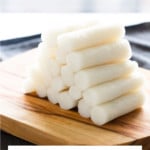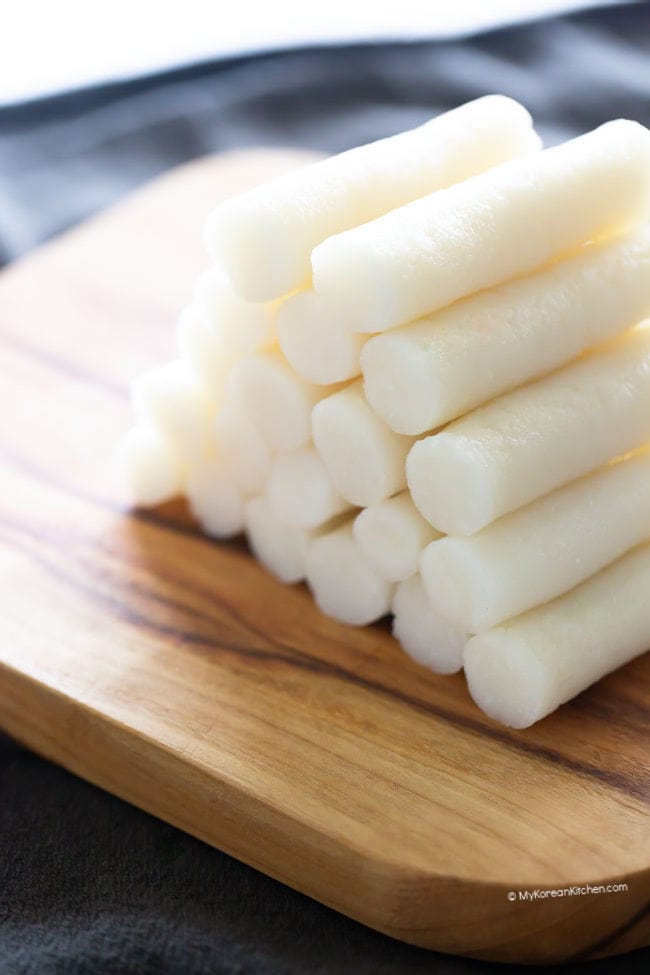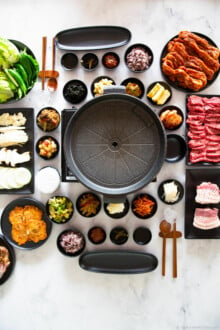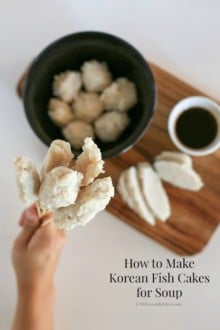My comprehensive guide on how to make Korean rice cake – Garaetteok at home. Below you will learn how to make rice flour, how to make garaetteok – cylinder rice cake, and how you can use them.
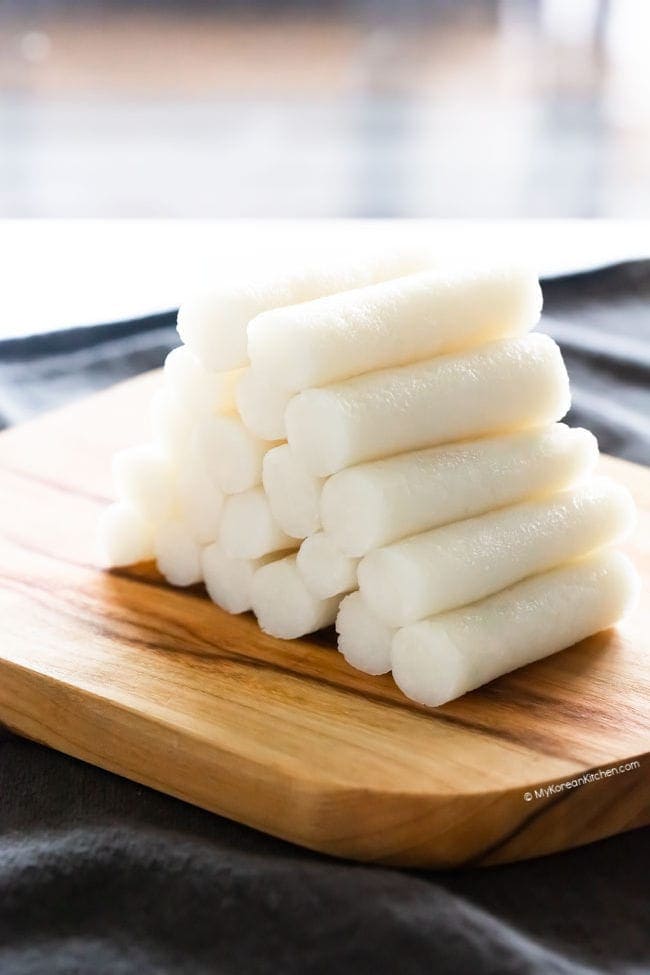
Garaetteok is a type of Korean rice cake commonly used when making tteokbokki (spicy rice cakes) and tteokguk (rice cake soup).
Typically I don’t make rice cakes from scratch as I can readily buy them from my local Korean grocer. However, I often get a request for garaetteok recipe as some people don’t have easy access to a Korean grocer at all, prohibiting them from making highly praised tteokbokki or tteokguk.
So with a happy heart, I’m pleased to share my garaetteok recipe. I hope you find it helpful!
Table of Contents
- What is Garaetteok?
- Making Your Own Rice Flour
- Tips for Success
- Key Ingredients You’ll Need
- Microwave Cooking Method
- Steamer Cooking Method
- Preparing for Tteokbokki
- Preparing for Tteokguk
- Storage and Freshness Tips
- Creative Ways to Use It
- Step-by-Step Video Tutorial
What is Garaetteok
Garaetteok / garae-tteok / garaeddeok (가래떡) is a type of Korean rice cake that is cylinder shaped. It is made with non-glutinous rice flour (mepssal-garu, 멥쌀가루) and has a slightly chewy and bouncy texture.
Garaetteok is white in color and does not have much taste on its own, so it is great in a stir fried dish (e.g. tteokbokki) or in a soup (e.g. tteokguk).
Short grain rice or medium grain rice works best when making garaetteok. (i.e. long grain rice such as Jasmin rice or basmati rice won’t work well.)
Rice grains are turned into wet-milled rice flour by soaking rinsed rice overnight and then ground into a fine powder. You can find detailed instructions below on how to make rice flour.
Making Your Own Rice Flour
1. Rinse 2.5 cups of rice (short grain rice or medium grain rice, e.g. sushi rice, 535 grams / 1.17 pounds) until the water drains clear. Then put the rice in a medium sized bowl and fill the bowl with some water. Soak it overnight or for 12 hours.
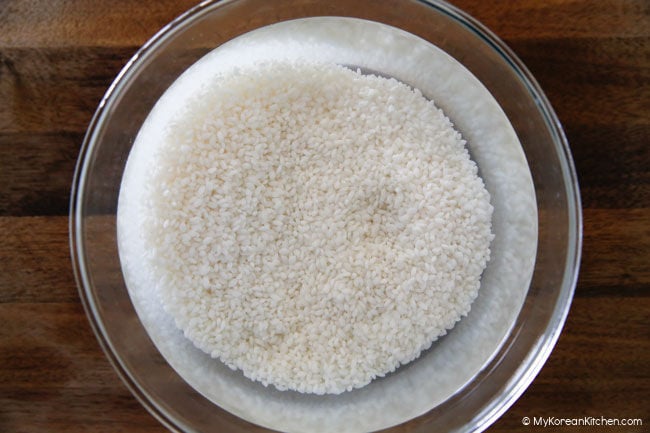
2. Strain the water away and air dry the rice for 1 hour. (The weight of the rice will increase to roughly 697 grams / 1.53 pounds.)
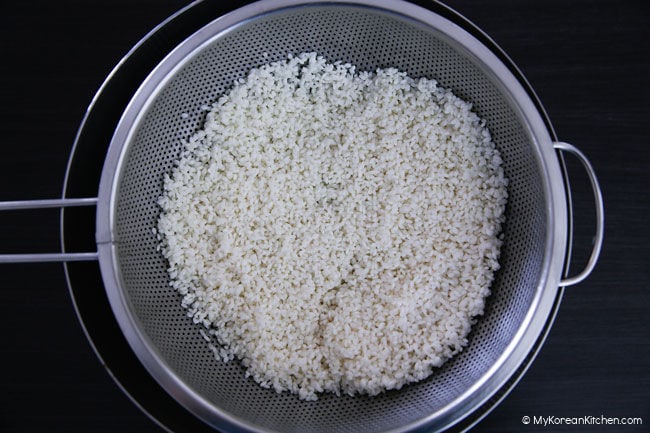
3. Grind the rice finely in a powerful food processor until the rice turns into fine powder. (You will have to stop and move around the rice flour with a scraper as it grinds. Otherwise, some rice flour and particles will stick to the wall of the processor and won’t get ground. The whole grinding process will take about 6 mins.
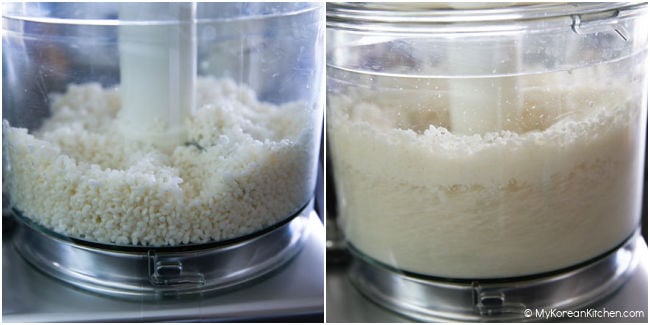
4. Sift the rice flour into a clean bowl in two or three lots. (It sifts better when you do it in smaller quantities.) Remove any clumps or unground rice grains. When the rice flour is sifted once, sift it one more time. If you ended up with too much unground rice grains, put them back into the food processor and grind them again until you get the fine rice flour. This should result in about 4.5 cups of rice flour.
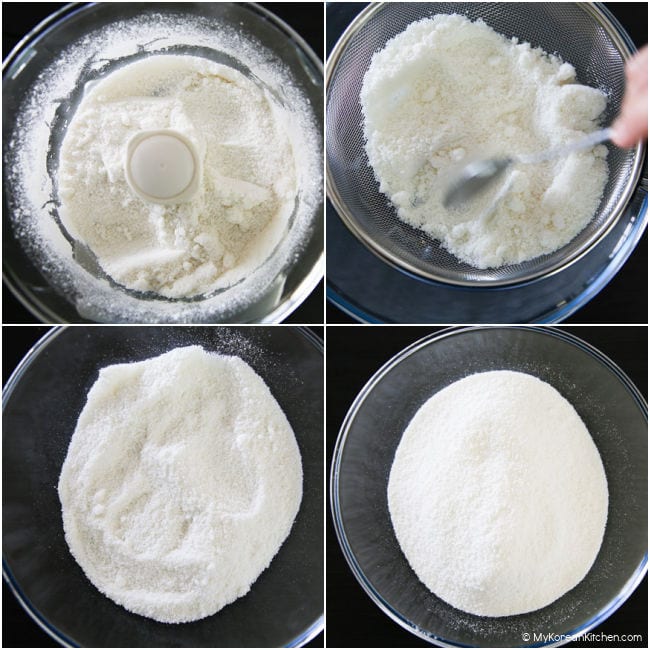
Please note that it is very hard to get the homemade rice flour to be as fine as professionally ground rice flour by a gristmill.
You can keep the rice flour in the freezer for up to 3 months in a sealed plastic bag.
Tips for Success
Rice Flour
- If you are lucky enough, you can buy the short grain rice flour from a Korean grocer. You can either find it at the freezer section or near the flour or rice and grains section. My local grocers didn’t have it, so I had to make it from scratch.
- When you make rice flour from scratch, the longer you soak the rice, the more finer rice flour you will get when you grind the rice. Try to soak it for at least 12 hours. If you are soaking the rice during hot and humid weather, soak the rice in the fridge, covered.
- If you are making your own rice flour, use short grain or medium grain rice (e.g. sushi rice). In my experiments, medium grain rice flour resulted in softer and more chewier rice cakes than short grain rice flour, but they both work wonderfully.
- You can store the leftover rice flour in the freezer. If you’re using frozen rice flour, defrost it in the fridge for 24 hours before use or take the frozen rice flour out and leave it at room temperature for 1 hour before use. Sift the rice flour before cooking it.
Rice Cake
- Adding the starch will give the rice cake a more soft and chewy texture, so I recommend you add it.
- The amount of boiling water you need will be determined by how dry or moist the rice flour you have is. This means you may need to add slightly more or less water than my recipe. (Naturally, the drier the flour the more water you will have to add.)
- When you have to add more boiling water, use a smaller measuring cup, one by one, so that you can modify the water amount in smaller increments. It will prevent you accidentally turning the rice water mixture into a rice porridge or soup.
- You can make steamed rice cakes using a microwave or a steamer. However, bear in mind that the dough can be easily overcooked in a microwave, particularly if you don’t add an adequate amount of water.
- Be sure to wear a pair of thick cotton gloves (layer 1) and food safe gloves (layer 2) on top on your hands. It will protect your hands from the heat when you take out the steamed rice cake dough. It also prevents the dough sticking on your hands while you are kneading and pounding the rice cakes.
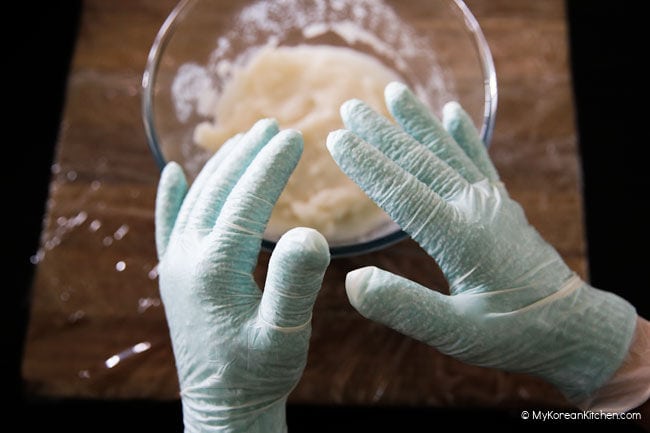
- When you shape the rice cake dough into a cylinder shape, rice cake shapes better and easier without the gloves on. By this stage, it won’t stick to your hands.
Key Ingredients You’ll Need
- 2 cups of wet-milled rice flour (300 grams), from short or medium grain (e.g. sushi rice)
- 1 Tbsp cornstarch
- 1 tsp fine salt
- 3/4 cups boiling water (for microwave version, 175 grams), divided into three sets of 1/4 cups
- 2/3 cups boiling water (for steamer version, 155 grams)
- 1/2 tsp sesame oil
* 1 Tbsp = 15 ml, 1 Cup =250 ml
** The amounts of water used above are based on homemade rice flour, which is wet-milled. Wet-milled rice flour is more moist than dry-milled rice flour, requiring less water for this recipe. If you are unable to find wet-milled rice flour from your grocer, I suggest you make your own following the instructions above. It’s very easy to make at home!
*** Above ingredients will results in about 450 grams (1 pound) rice cake.
Microwave Cooking Method
1. Combine rice flour, cornstarch, fine salt and 1/4 cups of boiling water in a microwave safe bowl. Mix them well. Add another 1/4 cups of boiling water and mix them again. (The rice cake mixture should be smooth and easy to stir, not hard like cookie dough.)
2. Cover the bowl with cling wrap, leaving a little gap for steam to escape. Put the bowl into a microwave and heat it up for about 2 minutes (based on 1250W microwave).
3. Take the bowl out and add 1/4 cups of the remaining boiling water. Cover the bowl again and return the bowl to the microwave and heat it up for a further 1 minute and 30 seconds. Remove the bowl from the microwave.
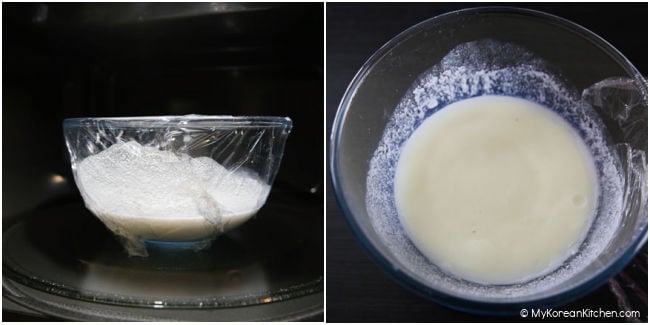
5. Cover the cutting board with a silicone baking mat or a few layers of cling wrap to prevent rice cake sticking onto it while shaping the rice cake. Carefully remove the rice cake dough from the bowl and place it on the mat.
6. Put a pair of thick cotton gloves (layer 1) and food safe gloves (layer 2) on top on your hands. (This is because rice cake dough will be very hot to touch.). Knead the rice cake dough. Pound it with a pestle for about 5 mins to give the rice cake a nice elastic texture.
Steamer Cooking Method
1. Combine rice flour, cornstarch, fine salt and 2/3 cups of boiling water in a bowl. Mix them well.
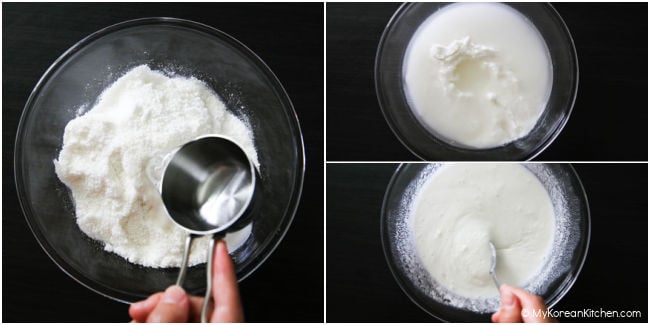
2. Cover the steamer with baking paper or a clean tea towel and place the rice flour mixture on top. Close the lid and steam it for 20 minutes over high heat.
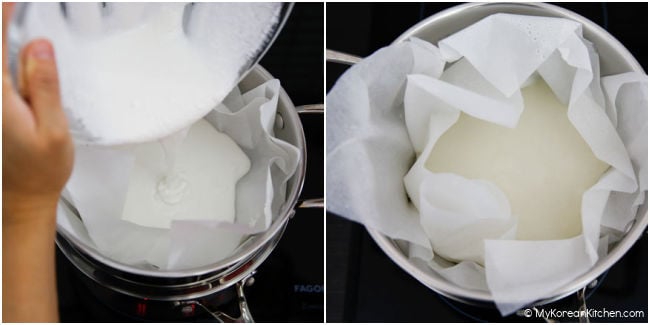
3. Cover the cutting board with a silicone baking mat or a few layers of cling wrap to prevent rice cake sticking onto it while shaping the rice cake. Carefully place the steamed rice cake dough on the mat.
4. Put a pair of thick cotton gloves (layer 1) and food safe gloves (layer 2) on top on your hands. (This is because rice cake dough will be very hot to touch.). Knead the rice cake dough. Pound it with a pestle for about 5 mins to give the rice cake a nice elastic texture. 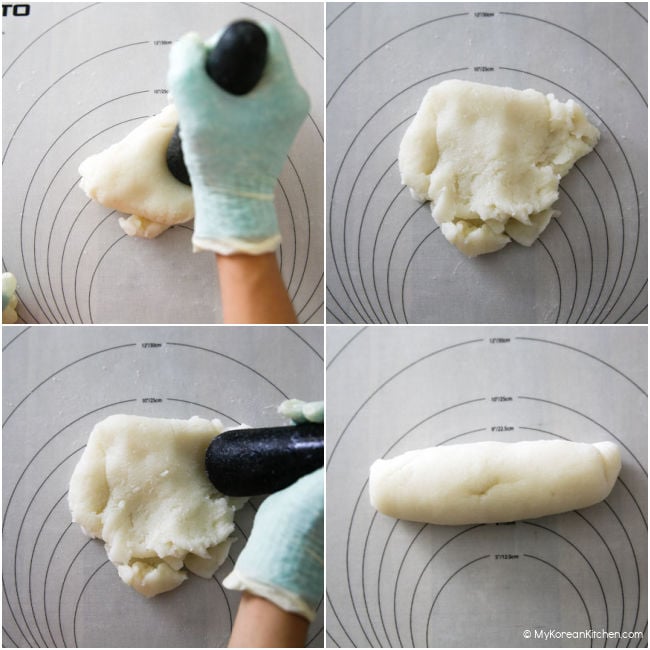
Preparing for Tteokbokki
1. Divide the rice cake dough evenly into 5 pieces.
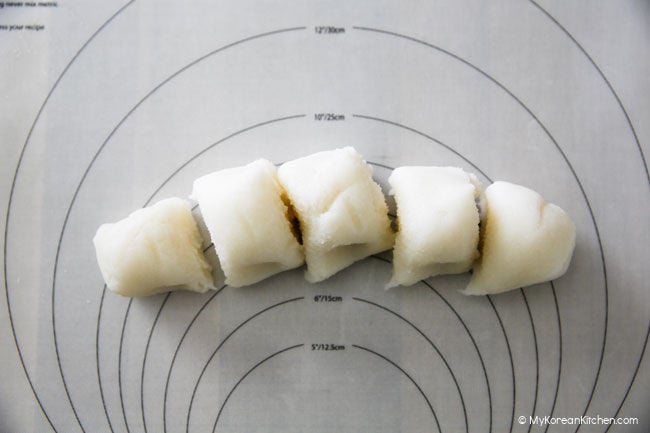
2. Drop the 1/2 tsp of sesame oil on to your palm and gently rub onto the rice cakes.
3. Roll the rice cake into 1 – 1.5 cm /0.4 – 0.6 inch diameter cylinder shaped rice cake and cut both ends.
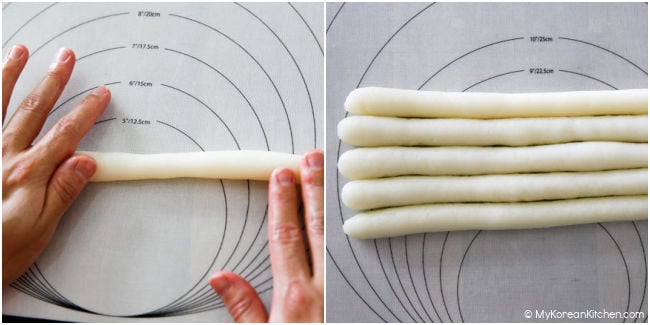
4. Cut the main part of the rice cake into 6 cm/4 inch long pieces (about little finger size). Now you have the rice cake ready to use in tteokbokki or other stir fry dishes.

Preparing for Tteokguk
1. Divide the rice cake dough evenly into 2 pieces.
2. Drop the 1/2 tsp of sesame oil on to your palm and gently rub onto the rice cakes.
3. Roll the rice cake into 2 – 3 cm/0.8 – 1.2 inch diameter cylinder shaped rice cakes.
4. Place the rice cakes on a large plate and cover with cling wrap. Refrigerate it for about 1 hour to harden it for easier slicing. However, if you are in a rush, you can still slice the rice cake soon after shaping it.
5. Slice thinly (about 0.5 cm / 0.2 inch thickness) and diagonally like oval shapes. Now you have the rice cake ready to use in your rice cake soup.
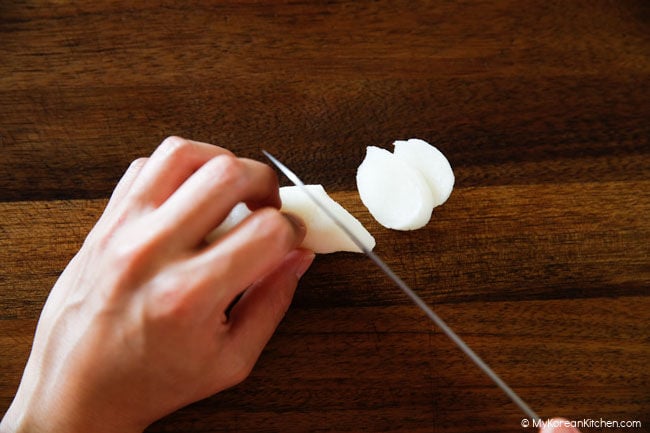
Storage and Freshness Tips
It is best to use the rice cake on the day you make it as it is fresher, softer and chewier. But if you want to store it for later use, you can freeze it for up to 1 month in a sealed plastic bag (e.g. ziplock bag). Be sure to slice the rice cake to your requirement prior to freezing.
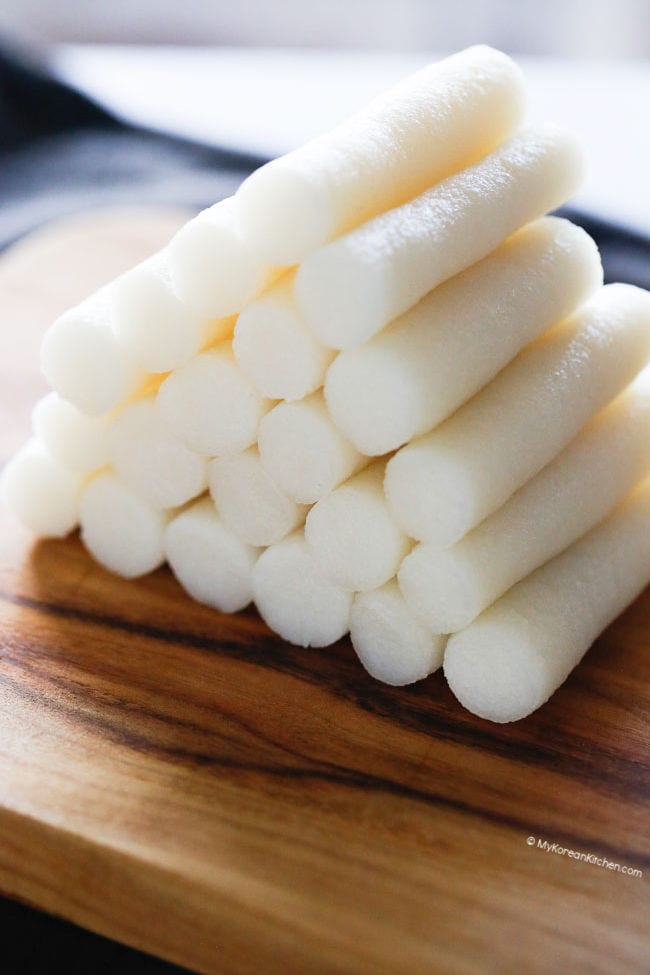
Creative Ways to Use It
Here are some recipes that use garatteok as ingredients. They are all very delicious, addictive and enjoyable in different ways. I hope you get to try these recipes soon.
- Tteokbokki (Spicy Rice Cakes)
- Tteokguk (Korean Rice Cake Soup)
- Tteok-Kkochi (Rice Cake Skewers)
- Gungjung Tteokbokki (Non-Spicy Tteokbokki)
- Rabokki (Ramen Tteokbokki)
- Rose Tteokbokki
Discover More! Explore our site for authentic Korean recipes—from mastering the art of perfect Korean BBQ at home to creating delicious banchan (Korean side dishes) and other tasty, easy Korean dishes. Let us inspire your next meal!
Step-by-Step Video Tutorial
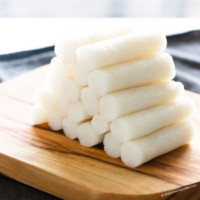
Garaetteok (Rice Cake Recipe)
Ingredients
- 2 cups wet-milled rice flour (300g), from short or medium grain (e.g. sushi rice)
- 1 Tbsp cornstarch
- 1 tsp fine salt
- 3/4 cups water (for microwave version, 175g), boiled, divided into three sets of 1/4 cups
- 2/3 cups water (for steamer version, 155g), boiled
- 1/2 tsp sesame oil
Instructions
HOW TO MAKE RICE FLOUR
- Rinse 2.5 cups of rice (short grain rice or medium grain rice, e.g. sushi rice, 535 grams / 1.17 pounds) until the water drains clear. Put the rice in a medium sized bowl and fill the bowl with some water. Soak it overnight or for 12 hours.
- Strain the water away and air dry the rice for 1 hour. (The weight of the rice will increase to roughly 697 grams / 1.53 pounds.)
- Grind the rice finely in a powerful food processor until the rice turns into fine powder. (You will have to stop and move around the rice flour with a scraper as it grinds. Otherwise, some rice flour and particles will stick to the wall of the processor and won’t get ground. The whole grinding process will take about 6 mins.
- Sift the rice flour into a clean bowl in two or three lots. (It sifts better when you do it in smaller quantities.) Remove any clumps or unground rice grains. When the rice flour is sifted once, sift it one more time. If you ended up with too much unground rice grains, put them back into the food processor and grind them again until you get the fine rice flour. This should result in about 4.5 cups of rice flour.
HOW TO MAKE RICE CAKE WITH A MICROWAVE
- Combine rice flour, cornstarch, fine salt and 1/4 cups of boiling water in a microwave safe bowl. Mix them well. Add another 1/4 cups of boiling water and mix them again. (The rice cake mixture should be smooth and easy to stir, not hard like cookie dough.)
- Cover the bowl with cling wrap, leaving a little gap for steam to escape. Put the bowl into a microwave and heat it up for about 2 minutes (based on 1250W microwave).
- Take the bowl out and add 1/4 cups of the remaining boiling water. Cover the bowl again and return the bowl to the microwave and heat it up for a further 1 minute and 30 seconds. Remove the bowl from the microwave.
- Cover the cutting board with a silicone baking mat or a few layers of cling wrap to prevent rice cake sticking onto it while shaping the rice cake. Carefully remove the rice cake dough from the bowl and place it on the mat.
- Put a pair of thick cotton gloves (layer 1) and food safe gloves (layer 2) on top on your hands. (This is because rice cake dough will be very hot to touch.). Knead the rice cake dough. Pound it with a pestle for about 5 mins to give the rice cake a nice elastic texture.
HOW TO MAKE RICE CAKE WITH A STEAMER
- Combine rice flour, cornstarch, fine salt and 2/3 cups of boiling water in a bowl. Mix them well.
- Cover the steamer with baking paper or a clean tea towel and place the rice flour mixture on top. Close the lid and steam it for 20 minutes over high heat.
- Cover the cutting board with a silicone baking mat or a few layers of cling wrap to prevent rice cake sticking onto it while shaping the rice cake. Carefully place the steamed rice cake dough on the mat.
- Put a pair of thick cotton gloves (layer 1) and food safe gloves (layer 2) on top on your hands. (This is because rice cake dough will be very hot to touch.). Knead the rice cake dough. Pound it with a pestle for about 5 mins to give the rice cake a nice elastic texture.
PREPARE RICE CAKE FOR TTEOKBOKKI (SPICY RICE CAKE)
- Divide the rice cake dough evenly into 5 pieces.
- Drop the 1/2 tsp of sesame oil on to your palm and gently rub onto the rice cakes.
- Roll the rice cake into 1 – 1.5 cm /0.4 – 0.6 inch diameter cylinder shaped rice cake and cut both ends.
- Cut the main part of the rice cake into 6 cm/4 inch long pieces (about little finger size). Now you have the rice cake ready to use in tteokbokki or other stir fry dishes.
PREPARE RICE CAKE FOR TTEOKGUK (KOREAN RICE CAKE SOUP)
- Divide the rice cake dough evenly into 2 pieces.
- Drop the 1/2 tsp of sesame oil on to your palm and gently rub onto the rice cakes.
- Roll the rice cake into 2 – 3 cm/0.8 – 1.2 inch diameter cylinder shaped rice cakes.
- Place the rice cakes on a large plate and cover with cling wrap. Refrigerate it for about 1 hour to harden it for easier slicing. However, if you are in a rush, you can still slice the rice cake soon after shaping it.
- Slice thinly (about 0.5 cm / 0.2 inch thickness) and diagonally like oval shapes. Now you have the rice cake ready to use in your rice cake soup.
Notes
- 1 Tbsp = 15 ml, 1 cup = 250 ml
- The amounts of water used above are based on homemade rice flour, which is wet-milled. Wet-milled rice flour is more moist than dry-milled rice flour, requiring less water for this recipe. If you are unable to find wet-milled rice flour from your grocer, I suggest you make your own following the instructions above. It's very easy to make at home!
- The above ingredients will result in about 450g (1 pound) rice cake.
- Cooking time above only accounts for making rice cake using a microwave. It doesn't count for making the rice flour from scratch.
- Lots of helpful tips are mentioned in the main post above. Be sure to read them before you make garaetteok to increase your chance of success.
Nutrition Info (per serving)
The nutrition information shown is an estimate provided by an online nutrition calculator. It should not be considered a substitute for a professional nutritionist’s advice.
